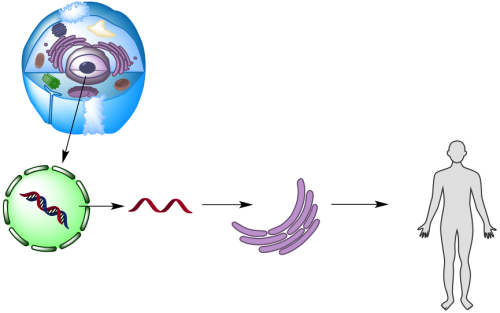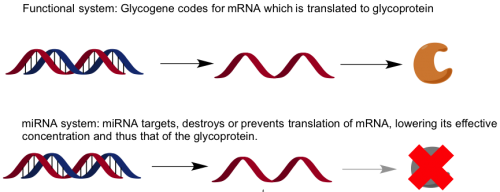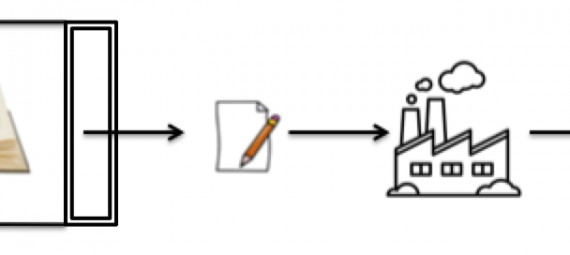A second layperson’s introduction to the research done by the Mahal laboratory. Before I go into details, let me just explain something known as The Central Dogma of Molecular Biology in simple terms.
For the sake of argument, consider yourself, and every person to be a robot. A complex assembly of different bits and pieces of machinery that make up a whole, capable of playing golf, commuting to work etc. This is, in fact, not far from the truth, the fact that our machinery is organic rather than metal really means nothing to me. Robots require complex assembly and maintenance. Let us imagine everything that is needed to know about this is in a big Manual of the Robot. Now this book is extremely valuable, so we keep it locked away. If we want to build a robot, or fix a robot, we get a pen and paper, go into the locked room, copy down the instructions we need to carry out our repairs etc., and leave the room with the book still chained away. Rather like expensive books in old libraries, the Manual of the robot is chained to the desk and cannot be taken out of the room. Once we have left the room, we have a transcript (our newly made copy) of the instructions, we can go to the factory and tinker away to our hearts content. This process is shown in Figure 1.
Figure 1

The workers can go into the Book storage room, note down the instructions, take them to the factory and then make the robot
Now, as I say, we are not so different to this. We are made of complex bits and pieces of machinery. These are not circuit boards and hydraulics, but rather thousands of molecular machines known as proteins. These form our bones, organs, cells, they break down our food, defend us from invasion and allow our senses to work. Again, we need instructions of how to build all of these from scratch, and repair them when necessary. All that needs to be known is now kept in the big Manual of Human. Now of course, it is not a chained book in a library room, but a loooooooong molecule called DNA which is safely chained in the nucleus, a central compartment within the cell. Apologies for biology class flashbacks, but suffice to say, DNA consists of a series of only 4 possible repeating parts, the order of which they appear in tells the reader how you make the protein (molecular machine) you want.
A quick aside, DNA is made of 4 parts… 4 parts just in differing order determine every one of you, every daffodil, every shark, every fly, EVERYTHING.
Now, the cell wants to make a protein, so it heads into the nucleus, with its molecular pen and paper (now a molecule called mRNA) and jots down what it needs to know. This mRNA can then leave the nucleus and head on over to the cell’s equivalent of the factory (the ribosome). Once at the ribosome, the mRNA is read and the cellular factory workers (more proteins) can make the protein by following the mRNA instructions. This process is shown in Figure 2, compare it to Figure 1, its really quite simple!
Figure 2

The cell can ‘go’ into the nucleus, transcribe the instructions into mRNA, mRNA leaves the nucleus and goes to the ribosome to make the protein.
Now that you are all expert enough in how we all work on a cellular level, I will ask you a (compound) question. ~You have the DNA of your mother and father (50:50). You are (genetically) 99.9% identical to EVERY other human on the planet. You are (genetically) 60% a banana. You all share this much of the instruction manual (DNA). Why then, are we all so different?
Well, the answer lies with the proteins. Yes, you have the same DNA as all these things. But some of it is never read, copied down, and made into protein. In a gross simplification, our body reads through the DNA and makes sure we never make a banana protein (hopefully). How then does the body pick and choose which genes it is ok with being read and made and which would turn us decidedly yellow and bendy?
I will return to the robot factory. Lets say the Robot Manual accidently had a page that told you how to make chocolate soufflé, this is because the factory used to make deserts. Nice, but not particularly useful to building robots. The factory workers have two options to stop this distraction from being made instead of the required robot parts. Firstly they can go into the library and stick the soufflé pages together, so no one can read the chocolate distraction, and no one will go on to make it. The second method is to allow the worker to go in, copy down the recipe onto his piece of paper, come out and then take his paper and rip it up. Shoot the messenger.
This is similar in cells. You can stop the making of banana proteins in humans by not allowing the bits of DNA that are useless to be read and by allowing useful bits to be read just fine. This is the primary method of protein control in the body. The second method is the shoot the messenger approach. The body has to intercept the mRNA (paper instructions) before it reaches the ribosome (factory) and the wrong protein is made. This second method is slightly less common, but it has a primary advantage in that it can be used to fine tune amounts of protein rather than just turn expression on or off.
One of the ways this is done in the body is using a new molecule, micro RNAs (miRNAs). What these molecules do is pair up with a protein that is essentially a giant pair of scissors, and with the miRNA acting as a Sat Nav or a basset hound, they hunt out the mRNA and destroy it (or at least prevent its action) before we are turned into banana people. This is shown in Figure 3. As I said, a benefit of this method is the fact that, unlike sticking the pages together and stopping all making of the protein, it can destroy loaaaaads of mRNA, lowering the protein levels completely, or maybe just some of the mRNA is targeted, and this leads to slightly less, but still some protein. This fine-tuning of levels is much more useful than just turning a protein off or on in maintaining the complex balance of components needed in complex machinery.
Figure 3

miRNA regulated protein quantities by inhibiting the mRNA or ‘shooting the messenger‘ less messenger, less protein.
Now I can practically hear the screaming of non-academics shouting, “It’s all very clever but why the hell are you bothering, and why are should we pay for it?!” Well, like with robot’s machinery, our proteins can breakdown and stop working or overwork. We don’t have an engineer to call in and fix us like the robot. Most of the time we don’t even know which bit of machinery or protein breaking down causes which diseases. An example is, we know that the sugar proteins on the surface of our cells (see my blog Sweet and Simple) have a lot to do with certain diseases, such as how well cancer spreads in the body. What we don’t know is which of the hundreds of proteins are important to the disease and which really have nothing to do with the cancer.
The Mahal laboratory has discovered that miRNAs can help us to find out. miRNAs silence proteins, so what we can do is get a cell and use the 2000 different miRNAs that exist to completely stop the production of various proteins. As each protein is removed, we can see which ones have the biggest effect on the cell, such as increasing the metastasis (traveling) rate of the cancer etc. Using a library of miRNAs we can screen the most complex of systems to find the key and important proteins. We can send this information to chemists who can then take on the role of designing drugs to target these important proteins. Why go to all this effort to find these important targets? Well, 90% of drugs that are made by chemists fail to reach your prescription. Most of them will be duds. We hope that by targeting ONLY IMPORTANT proteins we can lower that percentage, and increase the amount of drugs that end up working!
I hope that this has been an interesting bit of chemical biology, and you can appreciate the niftiness of taking biology’s own method of controlling who we are and applying it to widening the number and efficiency of medicines that scientists are able to produce.
If anyone is further interested, talk to me or visit this link.

